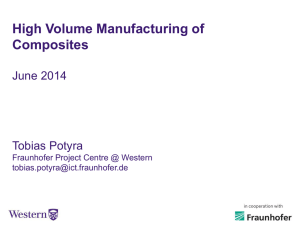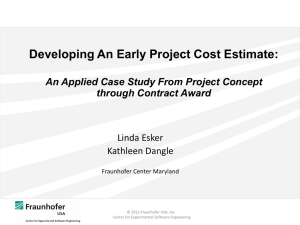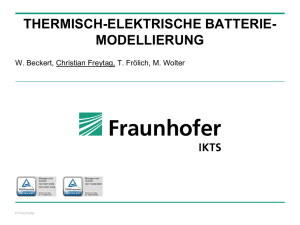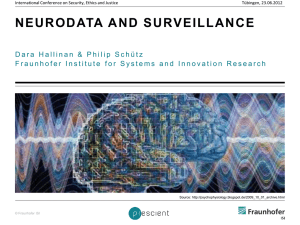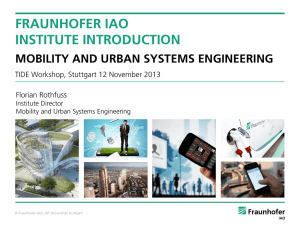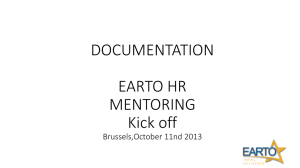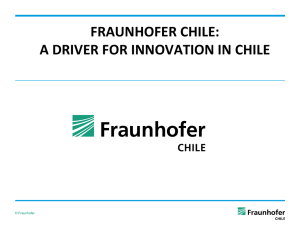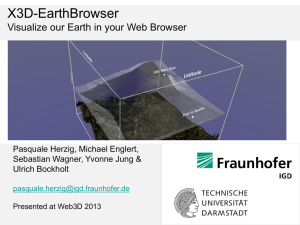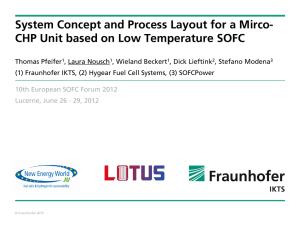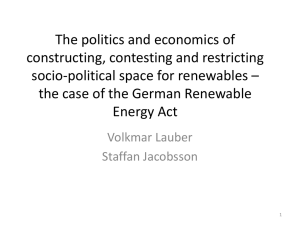2_Harald_Egner_KT_Scotland
advertisement
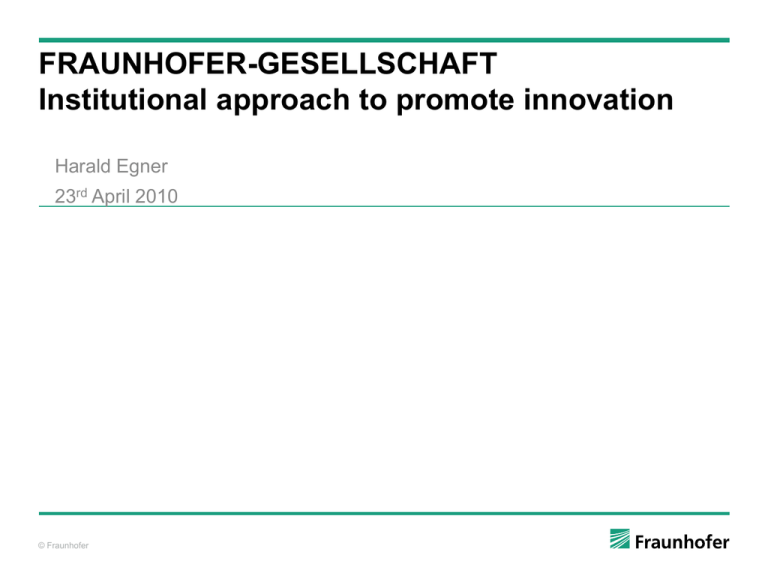
FRAUNHOFER-GESELLSCHAFT Institutional approach to promote innovation Harald Egner 23rd April 2010 © Fraunhofer Fraunhofer Introduction Alignment of funding models (FhG/UK) Human resources Cooperation activities UK © Fraunhofer The Fraunhofer-Gesellschaft The Fraunhofer-Gesellschaft undertakes applied research of direct utility to private and public enterprise and of wide benefit to society. Our Customers: Industry Service sector Public administration © Fraunhofer Guiding Principles of the Fraunhofer-Gesellschaft Mission The Fraunhofer-Gesellschaft promotes and undertakes applied research in an international context, of direct utility to private and public enterprise and of wide benefit to society as a whole. By developing technological innovations and novel systems solutions for their customers, the Fraunhofer Institutes help to reinforce the competitive strength of the economy in their region, throughout Germany and in Europe. Their research activities are aimed at promoting the economic development of our industrial society, with particular regard for social welfare and environmental compatibility. As an employer, the Fraunhofer-Gesellschaft offers a platform that enables its staff to develop the necessary professional and personal skills that will enable them to assume positions of responsibility within their Institute, in industry and in other scientific domains. © Fraunhofer The Fraunhofer-Gesellschaft in Germany Rostock Itzehoe Lübeck Bremerhaven Bremen Hannover 59 Institutes 17 000 employees Potsdam Braunschweig Teltow Magdeburg Cottbus Oberhausen Dortmund Duisburg Schmallenberg St. Augustin Aachen Euskirchen Wachtberg Darmstadt St. Ingbert Halle Schkopau Dresden Jena Chemnitz Ilmenau Würzburg Kaiserslautern Leipzig Erlangen Fürth Nürnberg Saarbrücken Karlsruhe Pfinztal Ettlingen Stuttgart Freising Freiburg Kandern EfringenKirchen © Fraunhofer Berlin München Holzkirchen Demands on a Fraunhofer Institute © Fraunhofer Scientific competence proved by the recognition of the scientific community Well-balanced financial mix of different independent sources Market success and entrepreneurial competence proved by contracts with industry and government Professional networking with other Fraunhofer Institutes and externals The Profile of the Fraunhofer-Gesellschaft 59 Institutes 17 000 employees 7 Groups: Information and Communication Technology Life Sciences Microelectronics Light & Surfaces Production Materials and Components - MATERIALS Defense and Security © Fraunhofer Fraunhofer Alliances Adaptronics Optic Surfaces Advancer Photokatalysis Ambient Assisted Living Polymer Surfaces Building Innovation Cleaning Technology Digital Cinema Simulation eGovernment Water Systems (SysWasser) Traffic and Transportation Energy Food Chain Management Grid Computing Nanotechnology © Fraunhofer Additive Manufacturing Vision Development of the Fraunhofer Institutes since 1949 8 GMD Institutes 60 Institutes of the eastern German Länder 50 40 30 20 10 Contract Research with own Institutes without own Institutes Zentrale/P2/Stand: 02-2008 © Fraunhofer Establishment of the “Fraunhofer Model“ 08 00 95 90 85 80 75 70 65 60 55 49 0 Key Activity Contract Research (million euros) 1 291 1 339 129 million € Other Revenues 1 164 1 068 63 million € Revenues EU-Projects 1 032 320 million € Revenues Public Projects (Federal, German Länder) 407 million € Revenues Contract Financing (Industry) 420 million € Institutional Funding 2005 2006 2007 2008 2009 (preliminary) © Fraunhofer Key Activity Contract Research (million euros) 1 291 1 339 129 million € Other Revenues 1 164 1 068 63 million € Revenues EU-Projects 1 032 Public Project Funding 320 million € Revenues Public Projects (Federal, German Länder) 407 million € Revenues Contract Financing (Industry) Contract Research (Industry revenue) 420 million € Institutional Funding 2005 © Fraunhofer 2006 2007 2008 2009 (preliminary) Performance related Institutional Funding Allocation of Institutional Funding Target Figures in 2009: 244.9 million € Performance related allocation criteria for institutional funding Institutional funding for a Fraunhofer Institute G3 = 10% respectively 40% of industry revenues G1: Fixed amount G2: Budget of Institute G3: Percentage of industry revenues G2 = 12% of budget G4: Percentage of EU revenues G1 = fixed amount 0,6 Mio € 25 © Fraunhofer 55 % Revenue Industry Fraunhofer Institute - Dual Institute Model Academia, university (more) basic research Human Resources Academic career - PhD - Lecturing University Institute © Fraunhofer Contract Research (Industry) Public funded Projects Institutional Funding Fraunhofer Institute Rules incentives The German Research Landscape *overall budget in billion euros Characteristics of Research Applied Research Fundamental Research Fraunhofer* 1,43 Federal/ German Länder Institutes 0,9 MPG* 1,442 Industry (internal and external expenditures) WGL* 1,122 55,41 AiF ~ 0,25 HGF* 2,42 Universities 9,2 Funding predominent institutional predominant private 1 HGF WGL AiF MPG Hermann von Helmholtz-Gemeinschaft Wissenschaftsgemeinschaft Gottfried Wilhelm Leibniz Arbeitsgemeinschaft industrieller Forschungsvereinigungen Max-Planck-Gesellschaft © Fraunhofer estimation Wissenschaftsstatistik 2008, Stifterverband 2 2007 3 2008 Source: Stifterverband für die Deutsche Wissenschaft, Destatis Fraunhofer Introduction Alignment of funding models (FhG/UK) Human resources Cooperation activities UK © Fraunhofer Technology Readiness Level Technology Assessment & Proving PreProduction Production Implementation TRL 9 8 7 6 5 Pre-production Process optimised for capability and rate using production standard equipment 4 3 2 1 © Fraunhofer Production Implementation Fully production capable process qualified on full range of parts over extended period Technology Assessment and proving Process Validated in Lab using development equipment Alignment of Funding Models UK Funding Bodies TRL / UK EPSRC 1 2 TSB 3 4 5 6 7 8 9 Fraunhofer Funding Mechanism Institutional Funding (3 – 5 years to market) © Fraunhofer Project Funding (2 - 3 years to market) Industrial Contracts (industry buying knowledge, applications 0.5 – 1 year) Fraunhofer Funding Model translated into TRL money to make knowledge 1 knowledge to make money 2 3 4 5 6 7 8 9 Fraunhofer Funding Mechanism Institutional Funding (3 – 5 years to market) © Fraunhofer Project Funding (2 - 3 years to market) Industrial Contracts (industry buying knowledge, applications 0.5 – 1 year) Creating competitive advantage for companies Creating Competitive Advantage for Companies TRL / UK 1 2 3 4 5 6 7 8 9 Fraunhofer Funding Mechanism Short term solutions Institutional Funding (3 – 5 years to market) © Fraunhofer Value for Money Project Funding (2 - 3 years to market) Industrial Contracts (industry buying knowledge, applications 0.5 – 1 year) Delivery Integrated Fraunhofer Model TRL / UK Fraunhofer Funding Mechanism 1 2 3 4 5 6 7 Uni Fraunhofer Institute Department inside institute Working group inside department © Fraunhofer 8 9 Development of technology area over time TRL / UK -2 years 1 Uni Uni +2 years Uni time © Fraunhofer 2 3 4 5 6 7 8 9 Market driven use of institutional funding TRL / UK -2 years 1 2 3 4 Uni 5 6 7 8 9 Creating performance related institutional funding annual effect +2 years time Investing institutional funding in industrial needs / markets typically 3-5 year effect © Fraunhofer Product Life Cycle of technology area revenue Turning SoA; becoming available through commercial providers (companies, consultants) Industrial Relevance for institute © Fraunhofer time Need for Innovation/Business Continuity revenue time © Fraunhofer Summary of Fraunhofer principals High autonomy of institutes Integrated approach / responsibility TRL 2/3 to 8/9 Performance related institutional funding inside Fraunhofer and inside institutes Market driven investment of institutional funding on business unit level risk mitigation Companies buying knowledge to achieve competitive advantage Fraunhofer brand „Spring board“ to high level career in industry © Fraunhofer Fraunhofer Introduction Alignment of funding models (FhG/UK) Human resources Cooperation activities UK © Fraunhofer Joseph von Fraunhofer Discovery of “Fraunhofer Lines“ in the sun spectrum New methods of lens processing Head of Royal Glass Factory © Fraunhofer The FraunhoferGesellschaft Researcher Inventor Entrepreneur e.g.: Innovation Award 2004 of the German Federal President for Electric Biochip Technology e.g.: 2 patent applications each working day e.g.: ~ €450 million revenues from industry (about 4000 contracts) p. a. Fraunhofer-Gesellschaft Human Resources 2005 2006 2007 2008 2009 Regular Staff 8 200 8 390 8 950 9 850 11 280 of which are limited contracts 2 780 2 990 3 480 4 230 5 220 Support Staff 4 200 4 380 4 680 5 190 5 600 12 400 12 770 13 630 15 040 16 880 Total As at December 31 of that year, including part-time jobs © Fraunhofer The top employers chosen by German students Universum Student Survey 2009 Natural Scientists 1. Max-Planck-Gesellschaft 2. Fraunhofer-Gesellschaft 3. Bayer 4. BASF 5. Roche 6. DLR 7. Novartis 8. Merck 9. Bayer Schering Pharma 10. BMW 11. Siemens 12. Boehringer Ingelheim IT Specialists 1. Google 2. IBM 3. SAP 4. Fraunhofer-Gesellschaft 5. Microsoft 6. Apple 7. Porsche 8. Siemens 9. Audi 10. Max-Planck-Gesellschaft 11. BMW 12. Intel Quelle: Universum Communications, Stand Mai 2009 © Fraunhofer Engineers 1. Audi 2. Porsche 3. BMW 4. Siemens 5. Daimler 6. EADS 7. Fraunhofer-Gesellschaft 8. Robert Bosch 9. Lufthansa Technik 10. Volkswagen 11. DLR 12. ThyssenKrupp In the employer ranking Fraunhofer comes in second Universum Student Survey 2009 23 points 20 points 19 points 17 points 14 points Quelle: Universum Communications, Stand Mai 2009 © Fraunhofer „Spring board“ to high level career Integrated approach along TRL levels High throughput – opportunities for promotion Academic and professional career in parallel Market driven investment into new ideas Understanding needs of companies to achieve / maintain competitive advantage Multidisciplinary and cross-sector approaches Building high quality networks Brand © Fraunhofer Fraunhofer Introduction Alignment of funding models (FhG/UK) Human resources Cooperation activities UK © Fraunhofer Levels of Cooperation - Fraunhofer institute / UK Cooperation level Joint research projects (FP7, EUREKA, bi-national) Joint research agenda (institute level) Joint research programme (DE / UK) Institutionalised Cooperation (Centre) Starting as joint Research Group (3 – 5 years) Setting up formalised institution Further steps depending on success over 3-5 years © Fraunhofer Institutionalised Fraunhofer Cooperation Fraunhofer DE Academia, university Human Resources Academic career - PhD UK © Fraunhofer Public funded Projects - Lecturing Institutional Funding University Institute Institution UK Rules, incentives (more) basic research Contract Research (Industry) Contract Research (Industry) Public funded Projects Institutional Funding FhI / DE Formal Agreement Thank you very much for your patience harald.egner@ipa.fraunhofer.de © Fraunhofer
